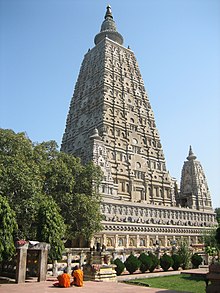| UNESCO World Heritage Site | |
|---|---|
 Mahabodhi Temple | |
| Location | Bodh Gaya, Bihar, India |
| Criteria | Cultural: i, ii, iii, iv, vi |
| Reference | 1056 |
| Inscription | 2002 (26th Session) |
| Area | 4.86 ha |
| Coordinates | 24°41′46″N 84°59′29″E / 24.6960°N 84.9913°E |
The Mahabodhi Temple (literally: "Great Awakening Temple") or the Mahābodhi Mahāvihāra, a UNESCO World Heritage Site, is an ancient, but restored Buddhist temple in Bodh Gaya, Bihar, India, marking the location where the Buddha is said to have attained enlightenment.[1] Bodh Gaya is 15 km from Gaya and is about 96 km (60 mi) from Patna. The site contains a descendant of the Bodhi Tree under which the Buddha gained enlightenment and has been a major pilgrimage destination of Buddhists for over two thousand years.
Some of the site's elements date to the period of Ashoka (died c. 232 BCE). What is now visible on the ground dates from the 6th century CE, or possibly earlier, as well as several major restorations since the 19th century. The structure, however, also potentially incorporates large parts of earlier work, possibly from the 2nd or 3rd-century CE.[2] Archaeological finds from the site indicate that the place was a site of veneration for Buddhists since at least the Mauryan period.[3] In particular, the Vajrasana, which is located within the temple itself has been dated to the third-century BCE.[4]
Many of the oldest sculptural elements have been moved to the museum beside the temple, and some, such as the carved stone railing wall around the main structure, have been replaced by replicas. The main temple's survival is especially impressive, as it was mostly made of brick covered with stucco, materials that are much less durable than stone. However, it is understood that very little of the original sculptural decoration has survived.[2]
The temple complex includes two large straight-sided shikhara towers, the largest over 55 metres (180 feet) high. This is a stylistic feature that has continued in Jain and Hindu temples to the present day, and influenced Buddhist architecture in other countries, in forms like the pagoda.[2]
- ^ "World Heritage Day: Five must-visit sites in India". Archived from the original on 14 August 2015.
- ^ a b c Harle, 201; Michell, 228–229
- ^ Fogelin, Lars (2015). An Archaeological History of Indian Buddhism. Oxford University Press. p. 195. ISBN 9780199948239.
- ^ Van Schaik, Sam; de Simone, Daniela; Hidas, George (2021). Precious Treasures from the Diamond Throne: Finds from the Site of the Buddha's Enlightenment. British Museum Press. p. 76. ISBN 9780861592289.

